We come now to the final chapter in the Bergmann pistol saga – the Danish M1910 and 1910/21 pistols. When Pieper (AEP) in Belgium contracted to build the 1908 Bergmanns for Spain, they also got the rights to build the guns under license for commercial sale. Bergmann’s own company had decided to get out of the pistol-making business and concentrate their arms production on heavy machine guns.
In addition to selling 1908 Bergmanns on the civilian market throughout Europe, Pieper managed to make a major contract sale of the guns to the Danish military in 1910. A few changes were requested to the design:
- Semicircular cutouts at the bottom of the magazine well, to allow a better grip on the magazine.
- Textured gripping surfaces on the magazines
- Changing the flat mainspring to an “S” shaped one
- Enlarged magazine catch
- Slightly larger grips
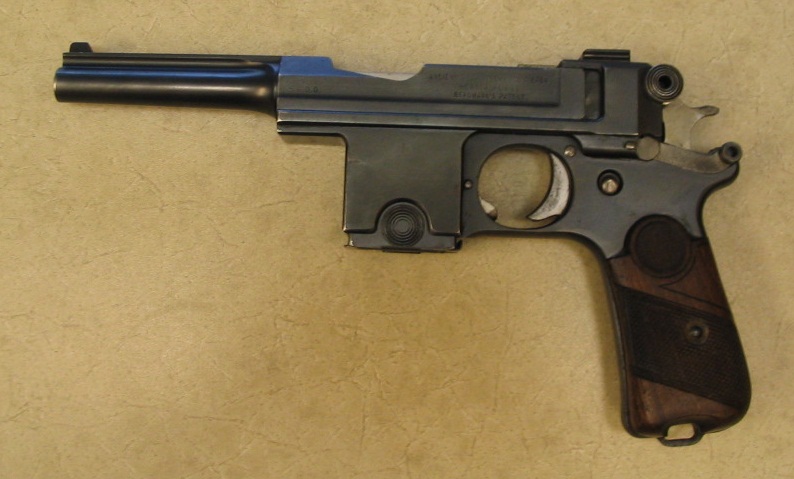
With these changes made, Denmark ordered 4,840 pistols in 1910. These guns bear two numbers, an AEP serial number in the 6,000-11,000 range located in the standard places (primarily on the front underside of the frame) and also a Danish property number from 1-4,840 stamped on the right side bridge at the read of the frame. They will also have a crown over “D” marking indication Danish acceptance and standard Belgian commercial proof marks. The Danish order was completed by 1912, and AEP continued making commercial Bergmann pistols. When World War I began and Germany occupied Belgium, they had the factory continue to produce the pistols for German use (these were in the 15,000-16,000 range of serial numbers, and did not have the Belgian proof marks). Production ended at the end of the war, but a few more guns in the 17,000 range were assembled form the remaining stock of parts.
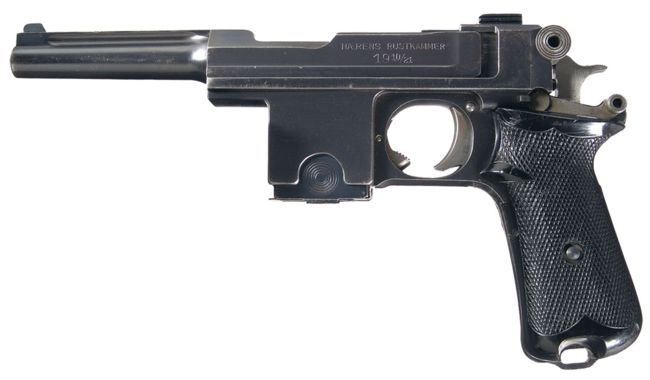
By the early 1920s, the Danish military was in need of more pistols and replacement parts for the existing ones, and was unable to get them from AEP – so they decided to produce them domestically instead. Production began in 1922, with a few more minor design changes under the designation M1910/21. These changes were a larger and stronger extractor, larger contoured grips made of Trolit (an early plastic) and replacing the sideplate catch with a screw – no significant mechanical changes. The first batch of 900 was made between 1922 and 1924, and are marked “HÆRENS TØJHUS” instead of having AEP’s name. A second batch of 1,904 pistols was made in 1924 and 25, marked “HÆRENS RUSTKAMMER”. These Danish made guns also had two different numbers; serial numbers starting at 1 and Danish issue numbers picking up at 4,840 where the Belgian guns left off.
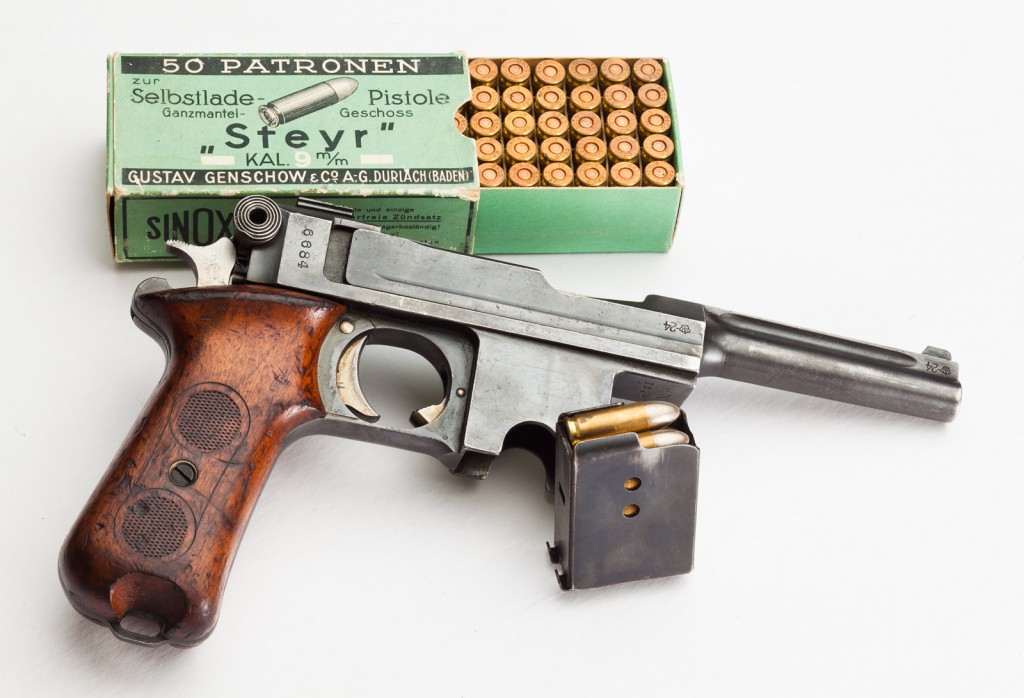
At the same time, most of the M1910 pistol in Danish inventory were refurbished and updated to the /21 configuration.
We have some video of the M1910/21, both at the range and in the shop for disassembly. I made these videos several years ago, and the shooting video has a few factual goofs in it – eventually I will have a chance to redo these with better info and in high definition. But for now, here they are:
My overall impressions of the Bergmann pistol are a big clouded by the aesthetic crush I have on them – I think they are a pretty darn comfortable pistol to shoot. R.K. Wilson disagrees, calling them “clumsy” and “very unhandy”. I do admit that magazine changes are slow (at least on the examples I’ve handled – the mag catch is very stiff, and removing the magazine causes the bolt to slam forward) and the 6-round capacity is a handicap. Still, they served the Danish military until 1946 (when they were replaced by the FN High Power). I still don’t have one in my personal collection, but eventually that will change!
Technical Specs
Caliber: 9x23mm Bergmann (aka 9mm Largo)
Weight: 36oz (1020g)
Overall length: 10.0 in (254mm)
Barrel Length: 4.0 in (102mm)
Magazine capacity: 6 rounds
Action: Short recoil
Locking System: Vertically-sliding block
Photos
Photos of a Bergmann-Bayard M1910/21 (click to download high-resolution copies)
[nggallery id=19]
References
Buffaloe, Ed. Bergmann Bayard (web site)
Ezell, Edward C. Handguns of the World. Stackpole Books, New York, 1981.
Wilson, R.K. Textbook of Automatic Pistols. Samworth, 1934 (reprinted by Wolfe Publishing, Prescott AZ, 1990).

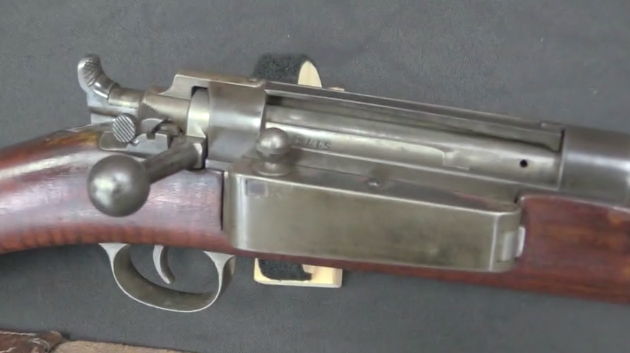
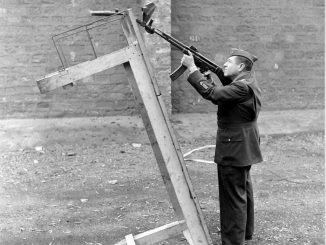
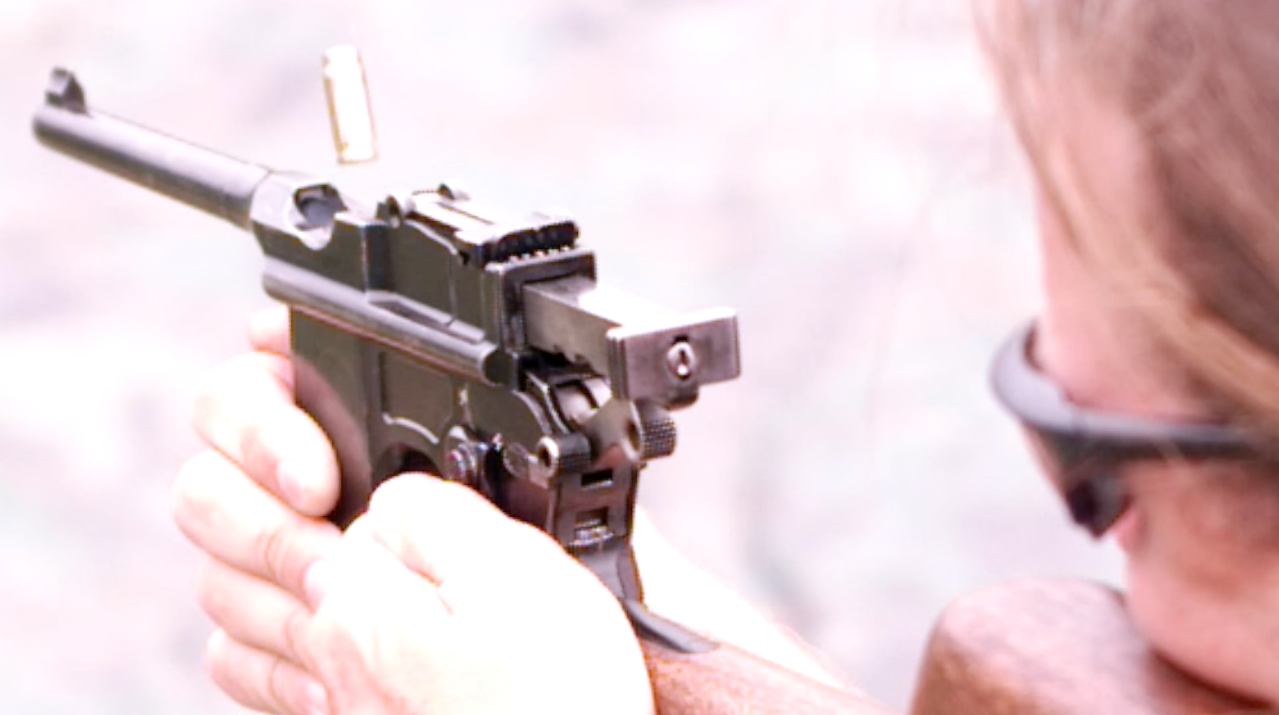
Many thanks for this great series of articles on the Bergmann pistols!
Clumsy to shoot? Small mag capacity? Somewhat oddball rounf? So what? I want one!! Theres just something about the design that appeals to the senses. I have several modern auto pistols, all good quality weapons but all have utilitarian features. I’d be happy to trade all of them for older models if I could. Same with the old bolt guns. Most have that “thing” that you just dont get from say, the newest AR designs. Thanks for showing these really intersting old weapons. They are actually quite inspirational in a way. I think seeing the level of craftsmanship that went into the older guns, even the less successful designs, show that attention to detail in your work really can make a difference.
The Bergmann-Bayard seems to have a good sight radius due to its overall length (accuracy and range). And with no fiddly-parts in the handle, it would be a good bludgeon should some unfriendly try to stab me.
In the event that I must shoot through a door, would I use this gun?
Could there be a carbine version of the Bergmann? I’d like to know.
As far as I’ve been able to tell, there were no Bergmann carbines made. Which is a bit unusual, considering that most of the popular pistols designs were also made into carbines (Luger, C96 Mauser, Mannlicher, etc).
The sight radius on the Bergmann is good, but the rear sight can potentially get a bit loose since it’s a removable piece. It’s probably not a practical problem, but worth knowing about.
“Bergmann carbines”
http://milpas.cc/rifles/ZFiles/Pistols/Semi-auto%20Pistols/Danish%20Bergman%20Bayard%20M1910%20&%20M191021/BERGMANN%20MODEL%201907%20KARABINER%20SEMI-AUTO%20CARBINE/BERGMANN%20MODEL%201907%20KARABINER%20SEMI-AUTO%20CARBINE..html
Sorry this link don’t work, google
“BERGMANN MODEL 1907 KARABINER SEMI-AUTO CARBINE”
Maybe this time.
https://dl.dropboxusercontent.com/u/20969954/Odds%20and%20ends/BERGMANN%20MODEL%201907%20CARBINE.jpg
We really need an edit function
Cool, thanks guys! What would a collector give for that baby!? And boy would I hate to mess with a fictional police tactical version of that carbine. Unlike sub-machine guns, pistol-caliber carbines are supposed to maximize range of a pistol round (or so I think). They don’t go full auto, since that ruins the purpose.
Here’s a carbine chambered for 9 mm Largo-the Spanish Destroyer carbine. Pictures are attached.
http://picturearchive.gunauction.com/4894134305/6282496/8b2db234e1ad92983deb58567e7bd435.jpg
http://www.deactivated-guns.co.uk/images/uploads/destroyer/bergman-026446_2.jpg
http://www.deactivated-guns.co.uk/images/uploads/destroyer/bergman-026446_7.jpg
http://milpas.cc/rifles/ZFiles/Spanish%20Rifles/SPANISH%20DESTROYER%20MILITARY%20&%20POLICE%20CARBINE/Image2188.gif
The 1910/21 Bergmanns seem to go for $1500-$2500 depending on condition.
…and why am I not surprised that you found one. 🙂
Not to forget the beautiful Mannlicher M1901/1905-pistol (also 1^carbine) which looks a lot like the Bergmann!
Apparently 9mm Steyr isn’t interchangeable with 9mm Largo. Are you sure about this Ian?
They’re not always interchangeable. The Largo is more powerful that the Steyr, and I have personally shot 9mm Steyr in a 1910/21 Bergmann without any functioning problems. I wouldn’t necessarily recommend using Largo in a gun designed for Steyr, though.
9mm Steyr is a 9 x 21, 9mm Largo is a 9 x 23. It’s a “one-way” interchange, mainly in 9mm Largo Astra 400 blowback automatics; they have a strong enough extractor and enough firing-pin protrusion to fire 9 x 19mm, or 9 x 20SR Browning (9mm Browning Long) as well.
The latter doesn’t always operate the mechanism, though.And the Astra is one of the few pistols designed for rimless rounds that has loose enough tolerances to chamber and fire semi-rimmed ones without some machining of the chamber mouth first.
Friendly advice; don’t try to use .38 Auto rounds in a Star Super without having the machining done. They’ll work through the magazine, bu once they’re in the chamber, the only way to remove one without firing it is to field-strip the pistol. Not fun, and not safe. (Personal experience here; I had a case of HUA-itis one afternoon, and got a nickel-plated .38 Auto mixed in a box of Blazer aluminum-cased Largos. An hour of “fun” ensued.)
A 9mm Largo round should not even chamber properly in a Steyr-Hahn chambered for 9 x 21, unless it has seriously over-spec headspace, as both rounds headspace on the case mouth.
BTW, most Steyr-Hahn Model 1911s (yes, they were officially designated that!) were converted to 9 x 19mm by the Nazis after the Anschluss, so everybody could use the same ammo. (They were even used by some of the Italian Fascist units that remained loyal to Mussolini after ’43.) They can be recognized by the “08” stamped on the slide.
So one still in 9 x 21, in good shape, probably has enough collector value that I wouldn’t want to take a chance of messing it up. That said, a 9 x 19 Steyr-Hahn has some collector value in and of itself, especially with verifiable unit markings.
It also makes an interesting “shooter”. If one I could afford came my way, I’d take it.
cheers
eon
The 9mm Steyr has a 23mm case, just like the Largo…
OK, Ezell calls it 9 x 22.7. So there apparently isn’t much actual difference. I stand corrected.
cheers
eon
Municion states that:
Steyr has 23,05mm case
http://www.municion.org/Steyr/9Steyr.htm
Largo has 23,06mm case
http://www.municion.org/9l/9largo.htm
The 9X21 I was familiar with was a means to get around the Italian ban on “military calibres”.
It was simply a 9mm parabellum with the case and chamber lengthened from 19mm to 21mm, everything else remained the same.
The 9×21 is armor-piercing ammo for “Veresk” SMG
ammo: http://en.wikipedia.org/wiki/9×21mm_Gyurza
SMG: http://en.wikipedia.org/wiki/SR-2_Veresk
Thanks Ian for this valuable series of Bergmann Pistols.
Vertically locked Bergmanns very closely follow the bases of Mauser C96 which
made earlier and guided the positive way to trace. Especially the breechbolt
mounting in the barrel extention and assembling method is a near copy of C96’s
in somewhat rather different shapes and location. Disconnector construction
also seems like dublicated. However, the pistol overall can be accepted as
simpler and stronger than its forerunner, especially on sliding type vertical
locking block construction.
Most negative feature of Bergmann pistols are their short trigger reach giving
no pointability. Holding a bergmann in the hand, is very much alike as holding
a hammer with a, not oval, but a cylindrical sectioned handle. Either things
can turn to all directions in the hand and not secured as pointable. Trigger
finger in other types, also points the gun to the required direction, but on
these pistols, it is nearly wraps around the handle with same vertical line with
other fingers like a fist. This feature, from very early types to the en, comes
from the nature of lay out of main components and possibly prevented the design
to reach more favorable levels.
O dear you copied most of the mistankes other whrithers made
The AEP Factory number s run from 4000 to 17900
The S spring, was put in the first 1700 pistols in denmark in 1912 pistols
Two testpistols were made in 1921 no 1/4841, and 2/4842 the tojhus pistols started at 3/4843markings of the Rustkammer and Tojhus overlap in a few hundred.They were ordred marked C/HR, but non is reported
I have a 19/21 but it is far nicer than any that ive seen any where. I have been told by gunsmiths tht it has not been reblued or altered in any way but they have no reason for its condition. It has brass plated triger,hammer,magazine base,rear site,and a couple of other features that i was told that it may have been an officers pistol. closest that they could come to manufacture date was 1926′
This is one of the older reviews of Ian’s but still very relevant. I think I reviewed most of the materials and comments and didn’t find any details on the internals of the firing mechanism (trigger/hammer/sear/safety). My model of 1910 was not taken care of very well and the externals don’t look very good. However, it is beautiful under the side plate. The fitting and use of flat springs is remarkable. I would have like to have seen more commentary and photos of that aspect of the pistol.
This is one of my favorite firearms and it is a pleasure to shoot.
Ian does a great job with his reviews. Thank you!